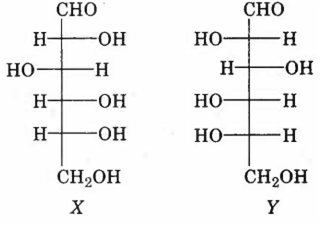 Multiple Choice Questions
Multiple Choice QuestionsAmong the following structures the one which is not a resonating structure of others is

I
II
III
IV
Among the following compounds, the one(s) that gives (give) effervescence with aqueous NaHCO3 solution is (are)
(CH3CO)2 O CH3COOH PhOH CH3COCHO
I II III IV
I and II
I and III
Only II
I and IV
Metal ion responsible for the Minimata disease is
Co2+
Hg2+
Cu2+
Zn2+
B.
Hg2+
Eating animal poisoned with mercury (Hg2+ ) causes deformity, known as minamata (minimata) disease which is characterised by diarrhoea, hemolysis, impairment of various senses, meningitis and death.
The order of decreasing ease of abstraction of hydrogen atoms in the following molecules
Ha > Hb > Hc
Ha > Hc > Hb
Hb > Ha > Hc
Hc > Hb > Ha
Among the following statements about the molecules X and Y, the one(s) which correct is (are)

X and Y are diastereomers
X and Y are enantiomers
X and Y are both aldohexoses
Xis a D-sugar and Y is an L-sugar
The rate of a certain reaction is given by, rate = k [H+]n. The rate increases 100 times when the pH changes from 3 to 1. The order (n) of the reaction is
2
0
1
1.5
If Cl2 is passed through hot aqueous NaOH, the products formed have Cl in different oxidation states. These are indicated as
-1 and +1
-1and +5
+1 and +5
-1and +3
